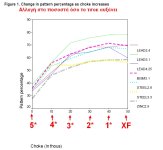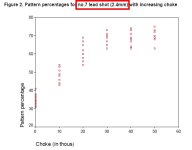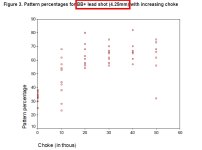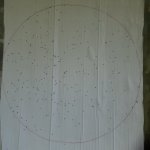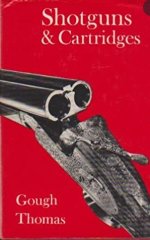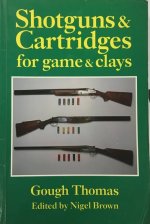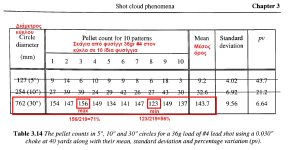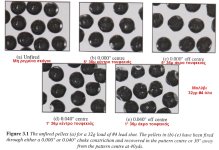Όποιος έχει όρεξη για διάβασμα ας διαβάσει αυτό.
Έψαχνα για τον Gough Thomas και το βρήκα.
Δείτε στην δεύτερη και τρίτη φωτογραφία 10 τουφεκιές με την ίδια κάνη και φυσίγγι από την ίδια παρτίδα για κάθε διαφορετικό τσοκ πόση μεγάλη διαφορά δίνουν οι τουφεκιές στα ποσοστά.
Στα #7: 10%-15%
Στα #BB: ξεπερνάει το 20% !!! φτάνει και το 55% στα 4*.
Και προφανώς δεν χρησιμοποιούσαν φυσίγγια "Ο Αρίστος".
Με μια τουφεκιά παίρνεις απλά μια ιδέα ... μπορεί να θεοποιήσεις ένα μέτριο φυσίγγι ή να πετάξεις ένα άριστο.
Στην πρώτη φωτό LEAD=ΜΟΛΥΒΙ, BISM=ΒΙΣΜΟΥΘΙΟ, STEEL=ATΣΑΛΙ, ZINC=ΨΕΥΔΑΡΓΥΡΟΣ
=====================
The most recent information on the subject comes from Roger Giblin and David Compton of
University College London’s former Ballistic Research Laboratory and was obtained during their
pioneering work on the ballistic performance of different types of cartridge. All firings used a
standard test barrel with the same widely-used linear tapered chokes at 40yd and cartridges from
the same batch for each test. Ten cartridges were fired from each choke from cylinder (0
thousandths of an inch constriction) to full choke (nominally 40 thous ) plus “super” (50 thous),
because fewer firings were found not sufficiently reliable to characterise the pattern of a given
choke.
They used three different lead cartridges with pellet size running from 2.4mm (No.7) to 4.25mm
(BB+), one bismuth at 3.1mm (No.4), two steel at 2.8mm (No.5) and 3.3mm (No.3), and one zinc
at 2.9mm (approx No.5).
The British Asscociation for Shooting and Conservation
======================
